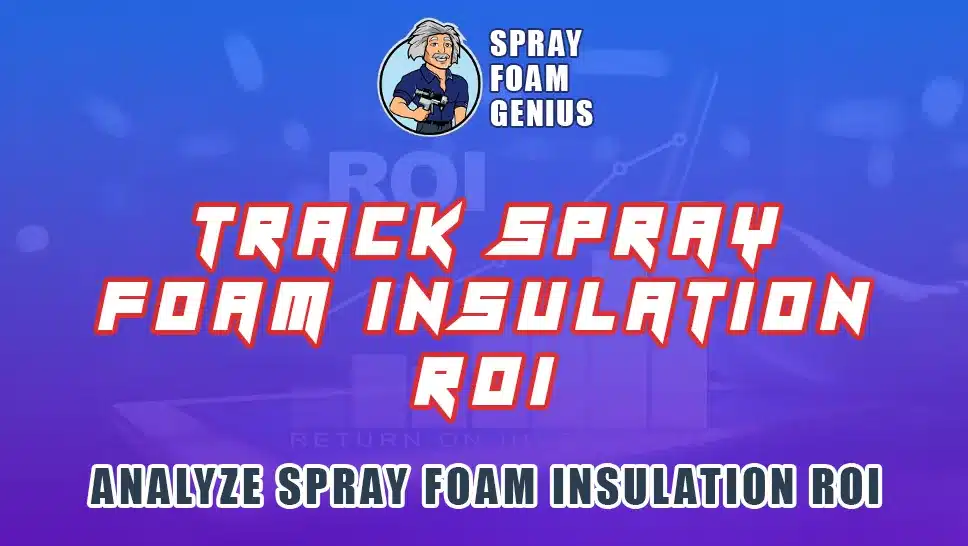
In the competitive world of spray foam insulation, understanding the return on investment (ROI) from your marketing efforts is crucial. At Spray Foam Genius Marketing, we specialize in helping spray foam insulation contractors like you optimize your online presence through professional SEO, Google My Business optimization, local SEO, website development, lead generation, social media marketing, and reputation management. This comprehensive guide will walk you through how to track and analyze your marketing ROI effectively, ensuring that your strategies yield the best possible results.
Why Tracking ROI is Essential
Understanding ROI
Return on Investment (ROI) measures the profitability of your marketing campaigns by comparing the cost of your marketing efforts to the revenue they generate. For spray foam insulation contractors, this means assessing how well your marketing spend translates into new leads, conversions, and ultimately, increased revenue.
The Importance for Spray Foam Contractors
Tracking ROI allows you to:
- Optimize Marketing Spend: Allocate the budget to the most effective channels.
- Measure Effectiveness: Identify which campaigns are driving results.
- Improve Strategy: Make data-driven decisions to enhance future marketing efforts.
Key Metrics to Track
1. Cost Per Lead (CPL)
Cost Per Lead (CPL) measures how much you spend to acquire a single lead. This is calculated by dividing your total marketing expenditure by the number of leads generated.
- Formula: CPL = Total Marketing Costs / Number of Leads
- Why It Matters: Lower CPL indicates a more efficient marketing strategy.
2. Conversion Rate
Conversion Rate is the percentage of leads that become paying customers. This metric helps gauge the effectiveness of your marketing and sales processes.
- Formula: Conversion Rate = (Number of Conversions / Number of Leads) × 100
- Why It Matters: A higher conversion rate means your marketing is effectively targeting potential customers.
3. Customer Acquisition Cost (CAC)
Customer Acquisition Cost (CAC) represents the total cost of acquiring a new customer, including all marketing and sales expenses.
- Formula: CAC = Total Costs of Sales and Marketing / Number of New Customers
- Why It Matters: Knowing CAC helps in budgeting and understanding the cost-effectiveness of your marketing efforts.
4. Lifetime Value (LTV)
Lifetime Value (LTV) estimates the total revenue a customer will generate during their lifetime.
- Formula: LTV = Average Purchase Value × Purchase Frequency × Customer Lifespan
- Why It Matters: Comparing LTV to CAC helps determine if your marketing investment is sustainable.
5. Return on Ad Spend (ROAS)
Return on Ad Spend (ROAS) measures the revenue generated for every dollar spent on advertising.
- Formula: ROAS = Revenue from Ads / Cost of Ads
- Why It Matters: A higher ROAS indicates more effective advertising.
Tools for Tracking ROI
Google Analytics
Google Analytics is a powerful tool that provides detailed insights into your website traffic, user behavior, and conversions.
- Features:
- Track traffic sources.
- Analyze user behavior on your site.
- Measure conversion goals.
CRM Software
Customer Relationship Management (CRM) Software helps track interactions with leads and customers, providing valuable data on sales performance.
- Features:
- Monitor lead sources.
- Track sales and conversions.
- Analyze customer interactions.
Marketing Automation Platforms
Marketing Automation Platforms like HubSpot or Marketo automate and track marketing campaigns, providing comprehensive ROI reports.
- Features:
- Track email marketing performance.
- Measure campaign engagement.
- Analyze lead nurturing processes.
Social Media Analytics
Social Media Analytics Tools provide insights into your social media performance, helping you track engagement and ROI from social channels.
- Features:
- Monitor social media metrics.
- Track campaign performance.
- Analyze audience engagement.
Analyzing Your Marketing Data

1. Set Clear Goals
Before diving into the data, define clear marketing goals. Are you aiming to increase brand awareness, generate leads, or drive sales? Clear goals will guide your analysis and help you focus on relevant metrics.
2. Compare Performance Against Benchmarks
Use industry benchmarks to evaluate your performance. Compare your metrics with industry standards to identify areas for improvement.
3. Analyze Trends Over Time
Examine how your ROI metrics change over time. Look for trends and patterns that indicate what’s working and what needs adjustment.
4. Conduct A/B Testing
Run A/B tests on different marketing strategies to determine which tactics perform better. Test variations in ads, landing pages, or email campaigns to optimize your ROI.
5. Gather Customer Feedback
Collect feedback from your customers to understand their experience and identify areas for improvement. Surveys and reviews can provide valuable insights into how your marketing is perceived.
Adjusting Your Strategy Based on Insights
1. Refine Targeting
Use your data to refine your targeting strategy. Focus on channels and demographics that yield the best results.
2. Optimize Budget Allocation
Allocate your budget to the most effective channels based on your ROI analysis. Shift spending away from underperforming areas to maximize returns.
3. Enhance Marketing Content
Based on performance data, adjust your marketing content to better resonate with your audience. Create more engaging and relevant content to drive better results.
4. Improve Lead Nurturing
Enhance your lead nurturing processes to increase conversion rates. Use insights from CRM and marketing automation tools to tailor your follow-up strategies.
5. Reevaluate Marketing Channels
If certain channels are not delivering the desired ROI, consider reevaluating or exploring new marketing channels.
Case Studies: Success Stories in Spray Foam Insulation Marketing
Case Study 1: Local SEO Success
Challenge: A spray foam insulation contractor struggled with low visibility in local search results.
Solution: We implemented a comprehensive local SEO strategy, including optimizing their Google Business Profile, building local citations, and improving on-page SEO.
Result: The contractor saw a 50% increase in local search traffic and a 30% increase in leads within three months.
Case Study 2: Social Media Engagement
Challenge: The client’s social media campaigns were not generating sufficient engagement or leads.
Solution: We revamped their social media strategy by creating targeted ads, engaging content, and running promotional offers.
Result: The client experienced a 60% increase in social media engagement and a 40% boost in lead generation.
Grow Your Business Today
Tracking and analyzing your marketing ROI is essential for maximizing the effectiveness of your marketing efforts. By understanding key metrics, utilizing the right tools, and continuously adjusting your strategy based on data-driven insights, you can ensure that your marketing investments yield significant returns.
At Spray Foam Genius Marketing, we specialize in helping spray foam insulation contractors navigate the complexities of digital marketing. If you’re ready to optimize your marketing ROI and achieve better results, contact us today.
Call us at 877-840-FOAM for USA and 844-741-FOAM for Canada, visit our website at Spray Foam Genius Marketing, or email us at [email protected]. We look forward to helping you enhance your marketing strategy and drive success for your business.
- How to Use Pinterest to Market Your Spray Foam Insulation Services - December 27, 2023
- How to Use LinkedIn to Grow Your Spray Foam Insulation Business - December 23, 2023
- How to Use Instagram to Showcase Your Spray Foam Insulation Projects - December 16, 2023

